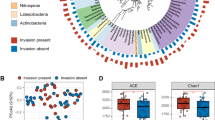Abstract
Prokaryotic communities of soils in oases of East Antarctica were studied at a model experiment with application of the succession approach. The total number of prokaryotes and filtered forms of prokaryotes, as well as the taxonomical diversity of the saprotrophic bacterial complex, were determined in two soil samples differing in organic matter content at temperatures of 5 and 20°C. We fixed the maximum total number of bacteria on the 14th day and the minimum number on the 1st and 160th (the end of the experiment) days in all variants. The amount and percentage of filtered forms of prokaryotes were the highest at the start of the experiment and the smallest on the 14th day. It is assumed that revival of Antarctica soils by humidification and incubation at temperatures above zero favors activation of dormant cells and their transition to viable status. Filtered forms of prokaryotes can be assigned to the pool of cells, which makes it possible to preserve bacteria at extremely low temperatures and without available water and nutrients. The succession approach enables more complete characterization of the taxonomic diversity of the saprotrophic bacterial complex and isolation of a wider genera of gram-negative bacteria than with a single inoculation of soil kept frozen. So it can be recommended for studying the prokaryotic community of Antarctica soils in model experiments.
Similar content being viewed by others
References
Abramov, A.A., Mironov, V.A., Lupachev, A.V., et al., Geocryological conditions of Antarctic oases, in Polyarnaya kriosfera i vody sushi. Vklad Rossii v Mezhdunarodnyi polyarnyi god 2007/2008 (Polar Cryosphere and Surface Water. Russian Contribution to International Polar Year 2007/2008), Kotlyakov, V.M., Ed., St. Petersburg, 2011.
Goryachkin, S.V., Gilichinskii, D.A., Mergelov, N.S., et al., Antarctica soils: first results, problems and research trends, in Geokhimiya landshaftov i geografiya pochv (k 100-letiyu M.A. Glazovskoi) (Landscapes Geochemistry and Soils Geography (to the 100th Anniversary of M.A. Glazovskaya)), Kasimov, N.S. and Gerasimova, M.I., Eds., Moscow, 2012.
Duda, V.I., Suzina, N.E., Polivtseva, V.N., and Boronin, A.M., Ultramicrobacteria: conception generation and contribution to biology, Mikrobiologiya, 2012, vol. 81, no. 4.
Zvyagintsev, D.G., Dobrovol’skaya, T.G., Bab’eva, I.P., and Lysak, L.V., Structural-functional organization of microbial communities, in Ekologiya na rubezhe XXI veka (nazemnye ekosistemy) (Ecology and the Boundary of XXI Century (On-Ground Ecosystems)), Moscow, 1999.
Kudinova, A.G., Lysak, L.V., Soina, V.S., et al., Bacterial communities in the soils of cryptogamic barrens of East Antarctica (the Larsemann Hills and Thala Hills Oases), Eur. Soil. Sci., 2015, vol. 48, no. 3, pp. 276–288.
Lysak, L.V., Dobrovol’skaya, T.G., and Skvortsova, I.N., Metody otsenki bakterial’nogo raznoobraziya pochv i identifikatsii pochvennykh bakterii (Soils Bacterial Variety and Soils Bacterial Identification: Research Methods), Moscow, 2003.
Lysak, L.V., Lapygina, E.V., Konova, I.A., and Zvyagintsev, D.G., Population density and taxonomic composition of bacterial nanoforms in soils of Russia, Eur. Soil Sci., 2010, vol. 43, no. 7, pp. 765–771.
Mergelov, N.S., Soils of wet valleys in the Larsemann Hills and Vestfold Hills Oases (Princess Elizabeth Land, East Antarctica), Eur. Soil Sci., 2014, vol. 47, no. 9, pp. 845–863.
Mergelov, N.S. and Goryachkin, S.V., Soils and soillike bodies in Antarctica (the Larsemann Hills), in Genezis, geografiya, klassifikatsiya pochv i otsenka pochvennykh resursov: Mat-ly nauch. konf., posvyashch. 150-letiyu so dnya rozhdeniya N.M. Sibirtseva. VIII Sibirtsevskie chteniya (Proc. Conf. Dedicated to 150th Anniversary of N.M. Sibirtsev. 8th Sibirtsev Readings “Genesis, Geography, Soils Classification and Estimation of Soils Resources”), Arkhangelsk, 2010.
Metody pochvennoi biokhimii i mikrobiologii (Methods of Soil Biochemistry and Microbiology), Zvyagintsev, D.G., Ed., Moscow, 1991.
El’-Registan, G.I., Mulyukin, A.L., Nikolaev, Yu.A., et al., Adaptogenic functions of extracellular auto-regulators of microorganisms, Mikrobiologiya, 2006, vol. 75, no. 4, pp. 446–456.
Altschul, S.F., Gish, W., Miller, W., et al., Basic local alignment search tool, J. Molec. Biol., 1990, vol. 215, no. 3, pp. 403–410.
Ganzert, L., Lipski, A., Hubberten, H.W., and Wagner, D., The impact of different soil parameters on the community structure of dominant bacteria from nine different soils located on Livingston Island, South Shetland Archipelago, Antarctica, FEMS Microbial. Ecol., 2011, vol. 76, no. 3, pp. 476–491.
Lane, D.J., 16S/23S rRNA sequencing, in Nucleic Acid Techniques in Bacterial Systematics, Chichester, 1991.
Maniatis, T., Fritsch, E.F., and Sambrook, J., Molecular Cloning: a Laboratory Manual, New York, 1982, vol. 545.
Oelschlägel, M., Ruckert, C., Kalinowski, J., et al., Sphingopyxis fribergensis sp. nov., a soil bacterium with the ability to degrade styrene and phenylacetic acid, Int. J. Syst. Evol. Microbiol., 2015, vol. 65, pt. 9, pp. 3008–3015.
Panikov, N., Contribution of nanosized bacteria to the total biomass and activity of a soil microbial community, Adv. Appl. Microbiol., 2005, vol. 57, pp. 245–296.
Roesch, L.F.W., Fulthorpe, R.R., Pereira, A.B., et al., Soil bacterial community abundance and diversity in ice-free areas of Keller Peninsula, Antarctica, Appl. Soil. Ecol., 2012, vol. 61, pp. 7–15.
Wynn-Williams, D.D., Response of pioneer soil microalgal colonists to environmental change in Antarctica, Microb. Ecol., 1996, vol. 31, no. 2, pp. 177–188.
Yabuuchi, E., Kosako, Y, Yano, I., et al., Transfer of two Burkholderia and an Alcaligenes species to Ralstonia gen. nov., Microbiol. Immunol., 1995, vol. 39, no. 11, pp. 897–904.
Zdanowski, M.K., Żmuda-Baranowska, M.J., Borsuk, P., et al., Culturable bacteria community development in postglacial soils of Ecology Glacier, King George Island, Antarctica, Polar Biol., 2013, vol. 36, no. 4, pp. 511–527.
Author information
Authors and Affiliations
Corresponding author
Additional information
Original Russian Text © A.G. Kudinova, L.V. Lysak, V.S. Soina, N.S. Mergelov, A.V. Dolgikh, 2018, published in Vestnik Moskovskogo Universiteta, Seriya 17: Pochvovedenie, 2018, No. 3, pp. 23–29.
About this article
Cite this article
Kudinova, A.G., Lysak, L.V., Soina, V.S. et al. Application of the Succession Approach in Studying the Prokaryotic Community in Soils of East Antarctica. Moscow Univ. Soil Sci. Bull. 73, 113–118 (2018). https://doi.org/10.3103/S0147687418030067
Received:
Published:
Issue Date:
DOI: https://doi.org/10.3103/S0147687418030067




